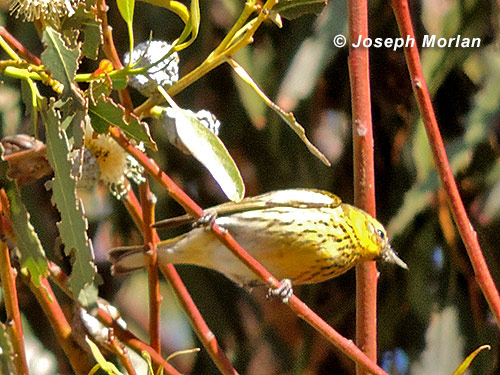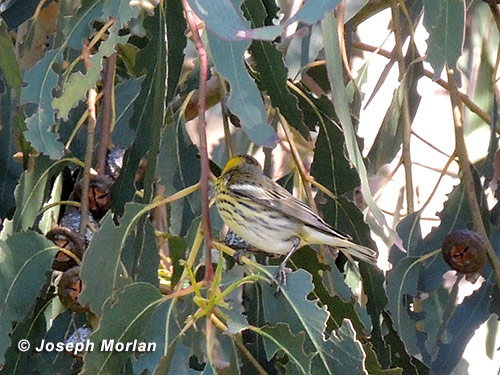Cape May Warbler (Setophaga tigrina)
East Bayshore Road, Palo Alto, Santa Clara County, CA
10 February 2013
Joseph Morlan
Photos © 10 February 2013 by Joseph Morlan. All rights reserved.
 This afternoon, Robbie Fischer and I finally made the trip down to Palo
Alto to look for the male Cape May Warbler which had been wintering in the area. It was still at the same spot
where it was originally found by Jeff Fairclough and Laurie Graham on 21 January 2013. Since then it has been seen
by many observers and has been photographed brilliantly. We parked at the end of Laura Lane and took the school
trail to the south side of the San Francisquito Creek levee and then walked back upstream to the end of the trail.
We met another birder who had not seen the bird, but he said that other birders had seen it about an hour earlier.
We later learned that the "other birders" were Ron Thorn and Leonie Batkin. We walked up to the famous
flowering Eucalyptus and within five minutes, the Cape May Warbler appeared, foraging in the upper canopy. Eventually
it came down to lower levels and showed reasonably well. A map with an arrow pointing at the tree is here.
This afternoon, Robbie Fischer and I finally made the trip down to Palo
Alto to look for the male Cape May Warbler which had been wintering in the area. It was still at the same spot
where it was originally found by Jeff Fairclough and Laurie Graham on 21 January 2013. Since then it has been seen
by many observers and has been photographed brilliantly. We parked at the end of Laura Lane and took the school
trail to the south side of the San Francisquito Creek levee and then walked back upstream to the end of the trail.
We met another birder who had not seen the bird, but he said that other birders had seen it about an hour earlier.
We later learned that the "other birders" were Ron Thorn and Leonie Batkin. We walked up to the famous
flowering Eucalyptus and within five minutes, the Cape May Warbler appeared, foraging in the upper canopy. Eventually
it came down to lower levels and showed reasonably well. A map with an arrow pointing at the tree is here.
I attempted photography with a Nikon P510 ultra-zoom with the results seen here.
Description
The following description is based on memory and on photos:
A small warbler, slightly smaller and more delicate than adjacent Yellow-rumped Warblers. The bill was very
fine and thinner compared to the Yellow-rumps, and the tail appeared shorter. The extensive yellow underparts were
the most distinctive feature. The face, breast and upper belly were a fairly bright yellow. Dark, blackish streaks
stretched across the upper breast and down the sides to the flanks, giving the bird the impression of being striped
like a tiger. The center of the breast was unstreaked. The belly and undertail coverts appeared to be white, but
photos show a band of yellow across the vent area.
The face was mostly bright yellow, except for the ear coverts and supercilium which were duller. A thin dark
eyeline was present. The crown was dull and some black coloration was evident on the forehead and chin, presumably
from Eucalyptus gum.
The nape and back were gray with dark streaks on the scapulars and lower mantle. The wings appeared gray
from fringing on the outer webs of blackish flight feathers and coverts. The median coverts were white forming
a strong upper wing-bar. The greater coverts were black with variable amounts of white webbing forming a whitish
wing panel. Lesser coverts were gray with black spots.
The tail had oval shaped white spots on the inner web that extended to the tip in the middle but the outer
webs were gray, forming triangular shaped gray corners.
Legs and feet were gray.

Discussion
Age and sex
This is almost certainly a male. Adult females do not normally look this bright. However determining the age
is not straighforward. The grayish fringes to the primary coverts and reduced streaking on the mantle support the
contention that it is SY. The pattern of the inner greater coverts may also suggest that. Males of all ages usually
lack the chestnut facial patch in winter. I prefer to leave the question of age open for now.
Status in California
This species was added to the CBRC review list at the January 2011 meeting based on the paucity of California
records in recent years. From approximately 1968 until 1980 there were 121 records; from 1980-1995 there were 88
records; from 1996-2009 there were 41 records. The downward trend was evident. During the period from 2000-2009
there was an average of 3.3 records per year, well below the four records per year guideline for CBRC review. A
decline in outbreaks of Spruce Budworm in recent decades is believed to be the cause of this decline (Patten and
Burger 1998). However, the committee has accepted 13 records since adding it to the review list for an average
of 6.5 records per year, well above the guideline.
This species was formerly included in the genus Dendroica. It was merged with Setophaga in the
52nd Supplement to the AOU Checklist. (The Auk 128:600-613, 2011). [PDF]
Reference
Patten, M.A., and Burger, J.C. 1998. Spruce Budworm outbreaks and the incidence of vagrancy in eastern North
American wood warblers. Can. J. Zool. 76:433-439. [PDF].
Update
Dan Singer and I revisited the site on 8 February 2013 and saw the bird again. The bird is still present through
early March and has been seen to cross the county line into East Palo Alto, San Mateo County on at least two occasions.
 This afternoon, Robbie Fischer and I finally made the trip down to Palo
Alto to look for the male Cape May Warbler which had been wintering in the area. It was still at the same spot
where it was originally found by Jeff Fairclough and Laurie Graham on 21 January 2013. Since then it has been seen
by many observers and has been photographed brilliantly. We parked at the end of Laura Lane and took the school
trail to the south side of the San Francisquito Creek levee and then walked back upstream to the end of the trail.
We met another birder who had not seen the bird, but he said that other birders had seen it about an hour earlier.
We later learned that the "other birders" were Ron Thorn and Leonie Batkin. We walked up to the famous
flowering Eucalyptus and within five minutes, the Cape May Warbler appeared, foraging in the upper canopy. Eventually
it came down to lower levels and showed reasonably well. A map with an arrow pointing at the tree is here.
This afternoon, Robbie Fischer and I finally made the trip down to Palo
Alto to look for the male Cape May Warbler which had been wintering in the area. It was still at the same spot
where it was originally found by Jeff Fairclough and Laurie Graham on 21 January 2013. Since then it has been seen
by many observers and has been photographed brilliantly. We parked at the end of Laura Lane and took the school
trail to the south side of the San Francisquito Creek levee and then walked back upstream to the end of the trail.
We met another birder who had not seen the bird, but he said that other birders had seen it about an hour earlier.
We later learned that the "other birders" were Ron Thorn and Leonie Batkin. We walked up to the famous
flowering Eucalyptus and within five minutes, the Cape May Warbler appeared, foraging in the upper canopy. Eventually
it came down to lower levels and showed reasonably well. A map with an arrow pointing at the tree is here.